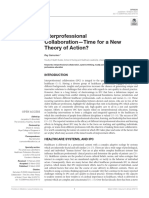Enhancing Collaborative Leadership in Healthcare: Addressing Ego Conflicts For Organizational Harmony and Improved Patient Care
Enhancing Collaborative Leadership in Healthcare: Addressing Ego Conflicts For Organizational Harmony and Improved Patient Care
Volume 9, Issue 10, October – 2024 International Journal of Innovative Science and Research Technology
ISSN No:-2456-2165 https://doi.org/10.38124/ijisrt/IJISRT24OCT1353
Enhancing Collaborative Leadership in Healthcare:
Addressing Ego Conflicts for Organizational
Harmony and Improved Patient Care
1.
Dr. Venugopal Reddy.I,
Medical Director, Ovum Woman and Child Speciality Hospital, Bangalore. (Corresponding Author)
2. 3.
Vidhya Shree R Dr. Adarsh Somashekar
Head- Human Resources and Business Development, Ovum Chairmain and CEO, Ovum Woman and Child Speciality
Woman and Child Speciality Hospital, Bangalore. Hospital, Bangalore.
Abstract:- In today’s complex healthcare environment, based strategies for resolution, and provide practical solutions
fostering collaboration between medical professionals and that can be implemented in healthcare systems worldwide.
administrative teams is essential for delivering high-
quality patient care. However, non-clinical conflicts, often A. Root Causes of Ego Conflicts in Healthcare
driven by differences in authority, communication gaps, Organizations
and ego clashes, can disrupt organizational harmony.
These conflicts between doctors, nursing heads, and Differing Priorities
corporate teams can negatively affect operational Medical professionals typically prioritize patient care,
efficiency, care outcomes, and staff morale. This article while corporate teams may focus on operational efficiency,
explores the root causes of these conflicts, highlights resource allocation, and financial sustainability. These
successful global strategies for resolving them, and conflicting priorities can lead to friction as clinical teams may
provides a comprehensive framework for promoting a feel that their work is being undermined by financial
culture of mutual respect and teamwork within considerations. In some cases, physicians may view
healthcare settings. By implementing these approaches, administrative policies as bureaucratic obstacles to delivering
healthcare organizations can create a cooperative care, while corporate teams may see physicians as resistant to
environment that enhances both staff satisfaction and necessary cost-saving measures.
patient outcomes. Moreover, the article examines how
these strategies can be applied globally to address similar For example, a 2020 survey conducted in a multi-
challenges across diverse healthcare settings. specialty hospital in India found that 42% of physicians
reported conflict with corporate teams over cost-containment
I. INTRODUCTION policies. These physicians felt that administrative measures,
such as limiting the use of certain diagnostic tests, interfered
Effective collaboration in healthcare is fundamental to with their ability to provide comprehensive care.
achieving optimal patient outcomes and ensuring operational
success. However, non-clinical issues such as ego-driven Role Ambiguity
conflicts between clinical leaders (e.g., doctors, nursing One of the key drivers of conflict in healthcare
superintendents) and corporate teams can erode teamwork organizations is role ambiguity. Without clear definitions of
and hinder progress. These challenges often arise from power roles and responsibilities, team members may overstep
dynamics, miscommunication, and differences in boundaries, fail to take ownership of tasks, or misinterpret
professional priorities. In the high-stakes environment of their decision-making authority. This is particularly prevalent
healthcare, where decisions impact patient lives, the friction in large hospital systems with multiple branches, where
between medical professionals and administrative staff can responsibilities may overlap between clinical and
escalate quickly. administrative teams.
According to a 2021 study, 68% of healthcare staff An analysis of role clarity in healthcare institutions
reported experiencing or witnessing ego-related conflicts, revealed that departments with poorly defined roles
with over half indicating that these conflicts negatively experienced a 30% higher incidence of internal conflicts
affected patient care outcomes. The complexity of healthcare compared to departments where roles were clearly delineated.
settings requires multidisciplinary teams to work seamlessly This lack of clarity often results in tension between clinical
together, but when communication and leadership structures heads and corporate administrators, each believing the other
fail, the repercussions can be significant. This article seeks to is infringing on their responsibilities.
delve into the root causes of these conflicts, present evidence-
IJISRT24OCT1353 www.ijisrt.com 1962
Volume 9, Issue 10, October – 2024 International Journal of Innovative Science and Research Technology
ISSN No:-2456-2165 https://doi.org/10.38124/ijisrt/IJISRT24OCT1353
Cultural Gaps C. Global Best Practices in Conflict Resolution
Healthcare professionals, particularly doctors, often
operate in a culture that values autonomy, quick decision- Mayo Clinic’s Integrated Model
making, and authority based on medical expertise. On the The Mayo Clinic, renowned for its collaborative
other hand, corporate teams tend to operate within a approach to healthcare, has implemented a model where
structured hierarchy, where decisions are made through decision-making is shared between clinical and non-clinical
established processes and protocols. These differing cultures staff. This model emphasizes teamwork, mutual respect, and
can create friction, as physicians may resist what they the importance of every stakeholder’s voice in critical
perceive as “top-down” decision-making from decisions. The clinic’s success in reducing conflicts can be
administrators. attributed to its structured leadership approach, which
prioritizes shared governance and transparent
In a study conducted by the American Hospital communication.
Association, 55% of surveyed healthcare executives cited
cultural differences between clinical and corporate teams as a Conflict Resolution Programs at Cleveland Clinic
significant source of internal conflict. Physicians often felt The Cleveland Clinic has employed conflict resolution
that their autonomy was being eroded by administrative specialists to mediate disputes between staff members,
directives, while corporate leaders struggled to balance reducing the impact of ego-driven conflicts. These specialists
clinical needs with organizational priorities, such as budget are trained to identify the root causes of conflicts and
constraints and compliance with regulations. implement tailored solutions to address them. Additionally,
the clinic emphasizes regular leadership training that includes
Emotional Intelligence emotional intelligence development and conflict management
The ability to manage emotions, both one’s own and skills.
those of others, is critical in high-pressure healthcare
environments. However, a lack of emotional intelligence Collaborative Governance Models in the NHS
(EQ) is often a significant contributor to ego conflicts. The National Health Service (NHS) in the United
Physicians, nurses, and administrators work in environments Kingdom has implemented collaborative governance models
where stress levels are high, and emotional responses can that focus on team-based decision-making and
escalate quickly if not managed properly. interdisciplinary cooperation. The NHS has created a culture
where clinical and administrative leaders work together to
Studies have shown that healthcare leaders with high make decisions, ensuring that both perspectives are
emotional intelligence are better able to navigate conflicts, represented. This approach has reduced the incidence of
leading to more collaborative and cohesive teams. On the conflicts and improved the overall work environment.
other hand, individuals with lower EQ may struggle to
manage their emotions in tense situations, leading to D. Proposed Framework for Resolving Ego Conflicts
escalated conflicts. A 2019 study in the Journal of Healthcare To foster collaboration and reduce conflicts in
Leadership found that conflict resolution success rates were healthcare settings, organizations can adopt a multifaceted
40% higher in teams where leaders had undergone emotional approach that includes clear role definitions, structured
intelligence training. communication, emotional intelligence training, and
collaborative decision-making models. The following
B. Impact on Patient Care framework outlines actionable steps that can be implemented
The consequences of ego conflicts are not limited to in healthcare organizations globally:
workplace harmony; they can have direct and detrimental
effects on patient care. Research has shown that unresolved Role Clarification
conflicts among healthcare teams can result in Clear role definitions are essential for reducing
communication breakdowns, delays in care, and decreased confusion and preventing conflicts over decision-making
overall efficiency. authority. A well-defined organizational chart can help clarify
the roles and responsibilities of each team member, ensuring
In a landmark study by the Institute of Medicine (IOM), that there is no overlap in duties or expectations.
it was found that poor communication between clinical and
non-clinical staff was a contributing factor in 70% of serious Example: A hospital may develop a detailed
adverse events in hospitals. Additionally, teams experiencing organizational chart that clearly defines the roles of medical
ongoing conflicts are more likely to exhibit low morale, heads, nurses, and administrative staff, along with their
reduced job satisfaction, and higher turnover rates, which specific decision-making authority. This chart should be
further disrupt the continuity of care. reviewed regularly and updated as necessary to reflect
changes in the organization’s structure.
IJISRT24OCT1353 www.ijisrt.com 1963
Volume 9, Issue 10, October – 2024 International Journal of Innovative Science and Research Technology
ISSN No:-2456-2165 https://doi.org/10.38124/ijisrt/IJISRT24OCT1353
Structured Communication Channels E. Impact on Patient Care and Organizational Harmony
Regular, structured communication meetings where Addressing ego-driven conflicts within healthcare
issues can be addressed in an open and non-confrontational organizations can have a profound impact on patient care and
environment are critical. These meetings should include overall organizational harmony. By fostering an environment
representatives from all relevant departments, ensuring that of collaboration and respect, healthcare institutions can
all voices are heard and that conflicts can be resolved before enhance the efficiency and quality of care provided.
they escalate. Furthermore, resolving internal conflicts improves staff
morale, reduces turnover, and helps maintain a positive work
Example: Monthly interdisciplinary meetings that include culture.
medical heads, nursing supervisors, and corporate team
members can be established to review operational challenges II. CONCLUSION
and discuss potential solutions.
Addressing non-clinical conflicts in healthcare,
Emotional Intelligence Training particularly those stemming from egos and
Emotional intelligence training is a key tool for conflict miscommunication, is critical for creating a harmonious work
resolution in healthcare settings. Training programs should environment and delivering high-quality patient care. By
focus on helping staff recognize and manage their emotions, focusing on leadership development, structured
as well as understanding the emotions of others. This can communication, emotional intelligence training, and
prevent conflicts from escalating and promote a more collaborative governance, healthcare organizations can
collaborative work environment. reduce conflict and foster a culture of teamwork and mutual
respect. These strategies not only improve staff morale and
Example: A healthcare organization may introduce emotional retention but also directly contribute to better patient
intelligence workshops as part of its leadership development outcomes.
program. These workshops would teach leaders how to
handle stress, communicate effectively, and resolve conflicts As healthcare systems continue to evolve, the ability to
in a constructive manner. manage interpersonal dynamics will become increasingly
important for maintaining efficiency and ensuring positive
Collaborative Decision-Making Models healthcare delivery. By implementing the strategies discussed
Shared governance models, where clinical and non- in this article, healthcare organizations across the globe can
clinical teams collaborate on major decisions, can reduce improve their internal dynamics, reduce conflicts, and
conflicts by ensuring that everyone’s input is valued. This ultimately provide better care for their patients.
approach fosters a sense of shared responsibility and reduces
the likelihood of ego clashes. REFERENCES
Example: A decision matrix could be implemented to ensure [1]. Clark, M., & Springer, P. (2019). “Nurse-Physician
that both clinical and corporate teams contribute to decisions Relationships: Impact on Nurse Satisfaction and
regarding resource allocation, policy changes, or operational Retention.” Journal of Nursing Administration, 39(8),
adjustments. 338-345.
[2]. Thomas, E., & Pollard, D. (2021). “The Role of
Conflict Mediation Committees Emotional Intelligence in Healthcare Leadership.”
Conflict mediation committees can be established to Health Management Review, 23(4), 212-224.
provide neutral mediation for disputes before they escalate. [3]. Garman, A., & Corrigan, J. (2020). “Leadership
These committees should include representatives from both Development in Healthcare: How Emotional
clinical and corporate teams and be trained in conflict Intelligence Can Bridge the Gap.” American Journal of
resolution strategies. Healthcare Management, 47(3), 150-157.
[4]. Krogstad, U. (2022). “Collaborative Leadership in
Example: A hospital could establish a conflict mediation Hospital Settings: A Comparative Study of U.S. and
committee responsible for addressing disputes related to U.K. Hospitals.” International Journal of Health Policy,
resource allocation or interdepartmental coordination. This 12(2), 110-118.
committee would work to identify the root causes of the [5]. Sutherland, J. (2020). “The Impact of Role Clarification
conflict and recommend solutions that benefit all parties. in Reducing Conflict in Healthcare Settings.” Health
Services Research, 55(5), 334-342.
[6]. Edmondson, A. (2019). “Psychological Safety and
Learning Behavior in Work Teams.” Administrative
Science Quarterly, 44(2), 350-383.
[7]. Gittell, J.H., & Weiss, L. (2021). “Coordinating Care in
Healthcare Teams: The Role of Leadership and
Communication.” Journal of Organizational Behavior,
42(1), 29-48.
IJISRT24OCT1353 www.ijisrt.com 1964
Volume 9, Issue 10, October – 2024 International Journal of Innovative Science and Research Technology
ISSN No:-2456-2165 https://doi.org/10.38124/ijisrt/IJISRT24OCT1353
[8]. McDaniel, R. (2019). “Leadership and Teamwork in
Complex Systems.” Journal of Health Organization and
Management, 33(4), 576-593.
[9]. Hart, E., & Warren, P. (2021). “Conflict Management in
Health Organizations: A Leadership Perspective.”
Health Management and Policy, 38(1), 125-138.
[10]. Jones, L., & Peter, S. (2020). “Organizational Health
and Staff Morale in Hospitals: The Impact of
Collaborative Decision Making.” Medical Leadership
Quarterly, 45(3), 90-101.
IJISRT24OCT1353 www.ijisrt.com 1965
You might also like
- The Resilient Healthcare Organization How To Reduce Physician and Healthcare Worker Burnout 1st Edition100% (2)The Resilient Healthcare Organization How To Reduce Physician and Healthcare Worker Burnout 1st Edition15 pages
- Philips Future Health Index 2022 Report Healthcare Hits Reset GlobalNo ratings yetPhilips Future Health Index 2022 Report Healthcare Hits Reset Global28 pages
- Beyond the Tests: How Portfolios Whisper of Equity and Engagement in Our Classrooms100% (1)Beyond the Tests: How Portfolios Whisper of Equity and Engagement in Our Classrooms2 pages
- Soft Beige Modern Table of Contents Document A4No ratings yetSoft Beige Modern Table of Contents Document A410 pages
- Philips Future Health Index 2024 Report Better Care For More People GlobalNo ratings yetPhilips Future Health Index 2024 Report Better Care For More People Global28 pages
- Assessment 2 - NURS-FPX4010 - Ebony RoseNo ratings yetAssessment 2 - NURS-FPX4010 - Ebony Rose6 pages
- Nurturing Talent and Preventing Burnout: Strategic HR Approaches To Enhance Staff Well - Being in Maternal and Child Healthcare SettingsNo ratings yetNurturing Talent and Preventing Burnout: Strategic HR Approaches To Enhance Staff Well - Being in Maternal and Child Healthcare Settings3 pages
- Conflict Management: Importance and Implications: Laurie MckibbenNo ratings yetConflict Management: Importance and Implications: Laurie Mckibben4 pages
- Highly Rated Innovative Staff Development in Healthcare Educational Ebook DownloadNo ratings yetHighly Rated Innovative Staff Development in Healthcare Educational Ebook Download15 pages
- Module 4 Conflict Transformation - AcknowledgementsNo ratings yetModule 4 Conflict Transformation - Acknowledgements53 pages
- Slidesgo Transforming Healthcare Innovative Solutions For A Health e Organization 20240814072338opv2No ratings yetSlidesgo Transforming Healthcare Innovative Solutions For A Health e Organization 20240814072338opv28 pages
- Transforming Leadership in Healthcare: Resolving Organizational Conflicts and Driving Team Accountability in Multi-Unit HospitalsNo ratings yetTransforming Leadership in Healthcare: Resolving Organizational Conflicts and Driving Team Accountability in Multi-Unit Hospitals3 pages
- Potential Wound Healing Activity of Citrus micrantha Rut. (Biasong) Ethanolic Peel Extract on Excised Cutaneous Wounds in Male Albino MiceNo ratings yetPotential Wound Healing Activity of Citrus micrantha Rut. (Biasong) Ethanolic Peel Extract on Excised Cutaneous Wounds in Male Albino Mice11 pages
- Unpacking Financial Interventions Link to Student Academic Performance in Public Secondary Schools: A Nyamira County Level Analysis, KenyaNo ratings yetUnpacking Financial Interventions Link to Student Academic Performance in Public Secondary Schools: A Nyamira County Level Analysis, Kenya11 pages
- Fostering Organizational Excellence in Healthcare: Addressing Staff Productivity, Workplace Gossip, and Competitor Challenges in Multi-Unit HospitalsNo ratings yetFostering Organizational Excellence in Healthcare: Addressing Staff Productivity, Workplace Gossip, and Competitor Challenges in Multi-Unit Hospitals2 pages
- Pearls Analysis of Saving and Credit Cooperatives of Jhapa100% (1)Pearls Analysis of Saving and Credit Cooperatives of Jhapa55 pages
- Enhancing Cloud Security with Fuzzy Logic a Comprehensive Approach to Authentication, Data Recovery, and PrivatenessNo ratings yetEnhancing Cloud Security with Fuzzy Logic a Comprehensive Approach to Authentication, Data Recovery, and Privateness12 pages
- Leadership Presentation Powerpoint Speaker NotesNo ratings yetLeadership Presentation Powerpoint Speaker Notes12 pages
- Evaluating the Effectiveness of Lean Management in Agriculture: The Case of Nature’s Gift Banana Farm, Lilongwe, MalawiNo ratings yetEvaluating the Effectiveness of Lean Management in Agriculture: The Case of Nature’s Gift Banana Farm, Lilongwe, Malawi5 pages
- A Smart Integrated System for Milk Collection & DispensingNo ratings yetA Smart Integrated System for Milk Collection & Dispensing5 pages
- A Study to Assess the General Mental Health Among College Students in Selected Colleges at Kannur DistrictNo ratings yetA Study to Assess the General Mental Health Among College Students in Selected Colleges at Kannur District5 pages
- Challenges Faced by Healthcare Staff and EmployeesNo ratings yetChallenges Faced by Healthcare Staff and Employees18 pages
- Mediating Conflicts: Challenges of School Grievance CommitteeNo ratings yetMediating Conflicts: Challenges of School Grievance Committee4 pages
- Leadership in Interprofessional Collaboration in Health CareNo ratings yetLeadership in Interprofessional Collaboration in Health Care12 pages
- Insights On Institutional Fatigue - Combating Healthcare Worker Burnout and Improving Patient Care - Wolters KluwerNo ratings yetInsights On Institutional Fatigue - Combating Healthcare Worker Burnout and Improving Patient Care - Wolters Kluwer9 pages
- The Role of Human Capital Development and Financial Deepening in Nigeria’s Industrial OutputNo ratings yetThe Role of Human Capital Development and Financial Deepening in Nigeria’s Industrial Output14 pages
- Ecological and Human Health of Polychlorinated Biphenyls (PCBs) Across Tide and Saline Influenced Hydrocarbon Mining Zones of Tropical Deltaic Wetlands, Southern NigeriaNo ratings yetEcological and Human Health of Polychlorinated Biphenyls (PCBs) Across Tide and Saline Influenced Hydrocarbon Mining Zones of Tropical Deltaic Wetlands, Southern Nigeria12 pages
- Ayasia Managing Modern Health Care OrganisationsNo ratings yetAyasia Managing Modern Health Care Organisations6 pages
- Leading Strategic Change in An Era of Healthcare Transformation ISBN 3319307754, 9783319307756 Direct Ebook DownloadNo ratings yetLeading Strategic Change in An Era of Healthcare Transformation ISBN 3319307754, 9783319307756 Direct Ebook Download14 pages
- Search for Binary Companions Around Millisecond PulsarsNo ratings yetSearch for Binary Companions Around Millisecond Pulsars13 pages
- University Libraries and the Use of Open Educational Resources (OERs) in Blended Learning (BL): Effective Strategies from Nairobi CountyNo ratings yetUniversity Libraries and the Use of Open Educational Resources (OERs) in Blended Learning (BL): Effective Strategies from Nairobi County7 pages
- Intercalating a Multi-Barreled Approach to Educational and Pedagogical Reform: A Brief Summation of our Publications on PedagogyNo ratings yetIntercalating a Multi-Barreled Approach to Educational and Pedagogical Reform: A Brief Summation of our Publications on Pedagogy12 pages
- Personal-Professional Attributes of Teachers and Learning Competence of Junior High School StudentsNo ratings yetPersonal-Professional Attributes of Teachers and Learning Competence of Junior High School Students28 pages
- social-medias-influence-on-modern-language-and-communication-skillsNo ratings yetsocial-medias-influence-on-modern-language-and-communication-skills12 pages
- Parental Influence on Aggression and Self-Esteem Among Young Adults: An Indian ContextNo ratings yetParental Influence on Aggression and Self-Esteem Among Young Adults: An Indian Context6 pages
- Quantifying, Measuring, and Correlating Socio- Cultural Variables: An Indispensable Technique for Diverse Fields of the Social SciencesNo ratings yetQuantifying, Measuring, and Correlating Socio- Cultural Variables: An Indispensable Technique for Diverse Fields of the Social Sciences12 pages
- Childhood Adversity and its Echoes in Adult Intimate RelationshipsNo ratings yetChildhood Adversity and its Echoes in Adult Intimate Relationships9 pages
- PSM AUG 30082021 0306PM 30082021 NADIA Managing Modern Health Care OrganisationsNo ratings yetPSM AUG 30082021 0306PM 30082021 NADIA Managing Modern Health Care Organisations16 pages
- Improvement Plan Tool Kit - Doc - Assessment 4No ratings yetImprovement Plan Tool Kit - Doc - Assessment 410 pages
- Astronomical Influences on Seismic Activity and Their Ecological Impacts: A Multidisciplinary ReviewNo ratings yetAstronomical Influences on Seismic Activity and Their Ecological Impacts: A Multidisciplinary Review12 pages
- Nurs FPX 4010 Assessment 2 Interview and Interdisciplinary Issue IdentificationNo ratings yetNurs FPX 4010 Assessment 2 Interview and Interdisciplinary Issue Identification5 pages
- Chronic Disease Prevention and Management: Community-Based Approaches and StrategiesNo ratings yetChronic Disease Prevention and Management: Community-Based Approaches and Strategies3 pages
- Extraction of Balanites aegyptiaca Seed Oil and Its Application in Soap Production from the Wood AshNo ratings yetExtraction of Balanites aegyptiaca Seed Oil and Its Application in Soap Production from the Wood Ash5 pages
- Modul 04 MK Ars 201 Hospitall Entrepreuneurship LeadershipNo ratings yetModul 04 MK Ars 201 Hospitall Entrepreuneurship Leadership14 pages
- Hay Guide Chart Job Evaluation 1702469523No ratings yetHay Guide Chart Job Evaluation 17024695235 pages
- Economic Viability of Sericulture in Comparison to Conventional Crop Cultivation in Korinthakunta Thanda, TelanganaNo ratings yetEconomic Viability of Sericulture in Comparison to Conventional Crop Cultivation in Korinthakunta Thanda, Telangana9 pages
- Effect of Broadcast Media in Mobilising the People for Enrolment of National Identification Number (NIN)No ratings yetEffect of Broadcast Media in Mobilising the People for Enrolment of National Identification Number (NIN)4 pages
- Slum Dwellers’ Access to Urban Basic Services: A Study of Two Informal Settlements in Dhaka CityNo ratings yetSlum Dwellers’ Access to Urban Basic Services: A Study of Two Informal Settlements in Dhaka City9 pages
- A Decade of Genome Editing: Comparative Review of ZFN, TALEN, and CRISPR/Cas9No ratings yetA Decade of Genome Editing: Comparative Review of ZFN, TALEN, and CRISPR/Cas910 pages
- Innovation in Healthcare Organizations 1674706384No ratings yetInnovation in Healthcare Organizations 167470638414 pages
- Non-Verbal Communication to Enhance Learning: Strategies of Filipino Language TeachersNo ratings yetNon-Verbal Communication to Enhance Learning: Strategies of Filipino Language Teachers4 pages
- Want To Improve The Well-Being of Health Workers - The System Itself Must Change Blogs CDCNo ratings yetWant To Improve The Well-Being of Health Workers - The System Itself Must Change Blogs CDC6 pages
- Customer Perception and Service Quality - A Comparative Study Among Traditional and Neo BanksNo ratings yetCustomer Perception and Service Quality - A Comparative Study Among Traditional and Neo Banks7 pages
- Healthcare Innovation Success Learning From Organisational Experience Full Text100% (16)Healthcare Innovation Success Learning From Organisational Experience Full Text15 pages
- Nursing Leadership Clinical Practicum JournalNo ratings yetNursing Leadership Clinical Practicum Journal5 pages
- Improving Employee Experience - Reducing BurnoutNo ratings yetImproving Employee Experience - Reducing Burnout4 pages
- ZCMB6142 Organizational Development and Change Management: by Jegathiswary Rajendran (ZP05123)No ratings yetZCMB6142 Organizational Development and Change Management: by Jegathiswary Rajendran (ZP05123)7 pages
- Managing Care How Clinicians Can Lead Change and Transform Healthcare - 1st Edition Educational Ebook Download100% (15)Managing Care How Clinicians Can Lead Change and Transform Healthcare - 1st Edition Educational Ebook Download14 pages
- Transformative Mediation in Healthcare OrganizationsNo ratings yetTransformative Mediation in Healthcare Organizations8 pages
- Exploring Corporate Strategy: 7 EditionNo ratings yetExploring Corporate Strategy: 7 Edition32 pages
- Leading Strategic Change in An Era of Healthcare Transformation (Management For Professionals) - ISBN 3319808826, 978-3319808826100% (23)Leading Strategic Change in An Era of Healthcare Transformation (Management For Professionals) - ISBN 3319808826, 978-331980882623 pages
- Leading Strategic Change in An Era of Healthcare Transformation Full Text PDF100% (19)Leading Strategic Change in An Era of Healthcare Transformation Full Text PDF16 pages
- Please Answer The Following Questions in About 250 Words Per Question. Please Have Your Responses Single Space, 12 Point FontNo ratings yetPlease Answer The Following Questions in About 250 Words Per Question. Please Have Your Responses Single Space, 12 Point Font2 pages
- Bangladesh University of Professionals: Term Paper On "Akij Group and Their Leadership Culture"100% (2)Bangladesh University of Professionals: Term Paper On "Akij Group and Their Leadership Culture"12 pages
- Assessment Brief: Module Code: Module Title: Distributed On: Hand in DateNo ratings yetAssessment Brief: Module Code: Module Title: Distributed On: Hand in Date14 pages
- Evaluating Customer-Based Brand Equity: A Case Study of the Top 5 Restaurants in BallariNo ratings yetEvaluating Customer-Based Brand Equity: A Case Study of the Top 5 Restaurants in Ballari13 pages
- Moral Decadence Amongst Youths in Tertiary Institution88% (17)Moral Decadence Amongst Youths in Tertiary Institution33 pages
- Questions On Project Human Resource Management100% (2)Questions On Project Human Resource Management6 pages
- McKinsey Special Collections BusinessStrategy100% (3)McKinsey Special Collections BusinessStrategy37 pages





















































































































